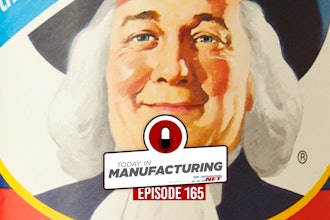By Lauren Kiesow, associate editor, Manufacturing.net
What do iPhones, catalytic converters, and glass polishers have in common? If you guessed the usage of rare earths in these products, then you’re correct.
Neither rare nor earths, these metals have been something of a hot topic as of late. This past September China decided to make headlines by limiting exports of rare earths to Japan and other nations. I didn’t realize what the implications were until I conducted further research and learned that China produces over 95 percent of the world’s rare earths supplies. What makes these metals “rare” is the fact that most often they are found in the presence of radioactivity. Extracting them economically and safely is what yields the moniker of “rare.”
To be fair, I completely understand the environmental and safety concerns over radiation. Quite honestly, I don’t want superfluous amounts of radioactivity polluting my part of the atmosphere. It would appear that other nations don’t either; hence, the dirty work—and the monopoly—falls on China. According to a New York Times article, Chinese processing factories are barely regulated—in some cases illegally operated—and have created vast toxic waste sites.
So, not only does China dominate the manufacture of rare earths, but it does so dangerously. Perfect. But considering the recent string of safety recalls on products ranging from toys to milk, I’m not surprised at the seedy way in which the rare earths business is being conducted.
If this is a recognized problem, why are more steps not being taken to implement safer facilities and protocols for the expanded manufacture of rare earths? If manufacturers don’t want to be dependent on a volatile nation, why is the urge to break free not stronger?
Apparently, there are companies who have started to take proactive measures to alter the rare earths landscape. Molycorp, an American company, plans to reopen their shuttered facility outside of Death Valley, California. But in order to do so, they need to completely renovate the plant to address environmental issues. Additionally, Lynas, an Australian mining company, is finishing a rare earths refinery in Malaysia. Of their new facility Lynas says, “Within two years…the refinery will be able to meet nearly a third of the world’s demand for rare earth materials.”
Assuming all goes according to plan (and how often does that happen?), it sounds like decent progress, but I don’t think it’s enough. The demand for technology and cars does not appear to be decelerating, so the need for these specific metals is going to continue to remain steady—if not increase.
Much like nations who depend on foreign gas and oil supplies, we will forever be at the mercy of the one with the monopoly, proclaiming injustice at price gouging and reduced exports but doing nothing to remedy the situation in a timely manner.
What do iPhones, catalytic converters, and glass polishers have in common? If you guessed the usage of rare earths in these products, then you’re correct.
Neither rare nor earths, these metals have been something of a hot topic as of late. This past September China decided to make headlines by limiting exports of rare earths to Japan and other nations. I didn’t realize what the implications were until I conducted further research and learned that China produces over 95 percent of the world’s rare earths supplies. What makes these metals “rare” is the fact that most often they are found in the presence of radioactivity. Extracting them economically and safely is what yields the moniker of “rare.”
To be fair, I completely understand the environmental and safety concerns over radiation. Quite honestly, I don’t want superfluous amounts of radioactivity polluting my part of the atmosphere. It would appear that other nations don’t either; hence, the dirty work—and the monopoly—falls on China. According to a New York Times article, Chinese processing factories are barely regulated—in some cases illegally operated—and have created vast toxic waste sites.
So, not only does China dominate the manufacture of rare earths, but it does so dangerously. Perfect. But considering the recent string of safety recalls on products ranging from toys to milk, I’m not surprised at the seedy way in which the rare earths business is being conducted.
If this is a recognized problem, why are more steps not being taken to implement safer facilities and protocols for the expanded manufacture of rare earths? If manufacturers don’t want to be dependent on a volatile nation, why is the urge to break free not stronger?
Apparently, there are companies who have started to take proactive measures to alter the rare earths landscape. Molycorp, an American company, plans to reopen their shuttered facility outside of Death Valley, California. But in order to do so, they need to completely renovate the plant to address environmental issues. Additionally, Lynas, an Australian mining company, is finishing a rare earths refinery in Malaysia. Of their new facility Lynas says, “Within two years…the refinery will be able to meet nearly a third of the world’s demand for rare earth materials.”
Assuming all goes according to plan (and how often does that happen?), it sounds like decent progress, but I don’t think it’s enough. The demand for technology and cars does not appear to be decelerating, so the need for these specific metals is going to continue to remain steady—if not increase.
Much like nations who depend on foreign gas and oil supplies, we will forever be at the mercy of the one with the monopoly, proclaiming injustice at price gouging and reduced exports but doing nothing to remedy the situation in a timely manner.






















